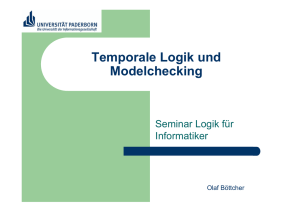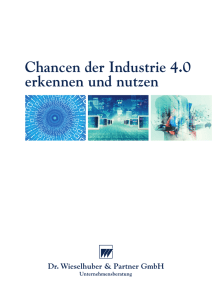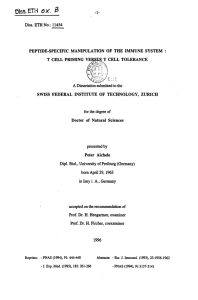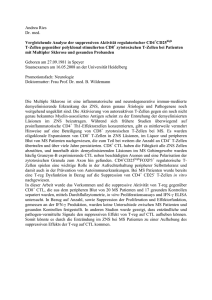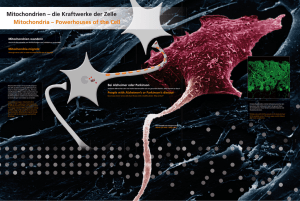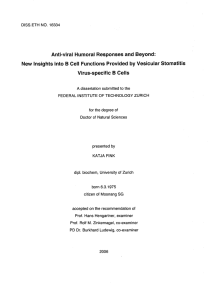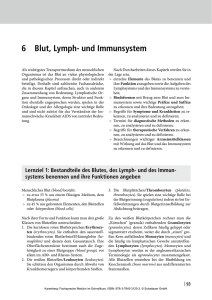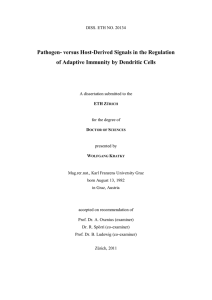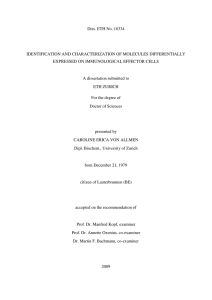Separatdruck aus - ETH E
Werbung
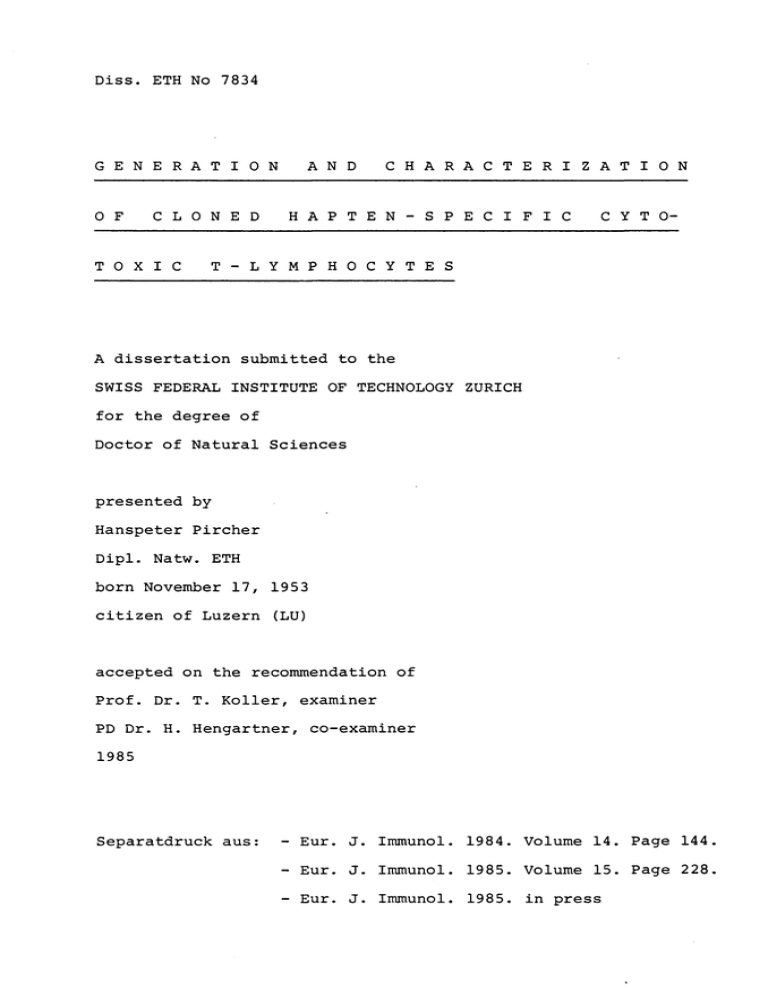
Diss. ETH 7834 No GENERATION OF for FEDERAL the submitted INSTITUTE the to OF TECHNOLOGY ZURICH of degree of Doctor CYTO¬ T-LYMPHOCYTES dissertation SWISS CHARACTERIZATION HAPTEN-SPECIFIC CLONED TOXIC A AND Natural Sciences presented by Hanspeter Pircher Dipl. born Natw. November of citizen accepted Prof. PD ETH Dr. Dr. H. 17, Luzern on T. the 1953 (LU) recommendation Roller, Hengartner, of examiner co-examiner 1985 Separatdruck aus: - Eur. J. Immunol. 1984. Volume 14. Page 144. - Eur. J. Immunol. 1985. Volume 15. Page 228. - Eur. J. Immunol. 1985. in press - 4 - Summary toxic (CTL) cell T response clones CTL based B) modified (bm6 and H-2K -mutant bm9), the cells. fact The does not clones A have the nerate to that AED-modified lysed by type be to self cells from (A categories of clones two In of and bm6 bm9 the supports notion covalently linked to for plus foreign antigen molecule mutated mutant to arginine. target cells that H-2K mice -mutant H-2K the has hapten) the H-2K the of two single free cysteine (which might be reactive H-2K reactivity patterns against hapten different on ethylene AED-specific stimulator and using target demonstrated mice -mutant of proliferation analysis and Vmti and sulfhydryl the restricted. H-2 hapten-specific and Cytotoxicity H-2K with (N-iodo-acetyl-N-(5-sulfonic-l-naphtyl) was restricted cytotoxic Their established. were against autologous cells modified reagent AED diamine) clones AED-specific cyto¬ restricted, H-2D and H-2K study this In hapten the molecules cytotoxic were T AED to cell ge¬ re¬ cognition. A of panel H-2K monoclonal molecules target cells nize cluster nal a domain type B was used CTL clones. of whereas with mAb to of inhibit for gest that different regions of determinants of H-2 restricted indicate analysis also and determinants be self identical. that both the cytotoxicity. in H-2 recog¬ second the exter- inhibited only was clustered These The in findings sug- serve as self results of this molecules allodeterminants involved which types of clones molecule. H-2K the AED-modified of allodeterminants region of the H-2K N-terminal in molecule of against antibodies located H-2K inhibition lysis the Monoclonal the specific directed (mAb) allodeterminants (Cl-domain) clones observed the by antibodies recognized by restriction do not mAb need to 5 - A tured C57BL/6 stage anti-AED-self recognition cell of lysis CTL effector CTL fic cells secondary effector that the very close The mAb to The the at Anti-AED mAb specifi¬ but not all some and clones bulk of AED- cul¬ anti-AED Furthermore cells. to the anti-AED not site bound of the adjacent region the last found clones: 17OK, inhibition release but membrane of cell of how¬ were, the that indicates which protein with and 100K. 1-17 lymphocyte mediated by 1-17 thymocytes, part a the with 1-17 binds function to is expressed node lymph cell of cells and prolifer¬ morphology. spleen T studies a suggested that carbohydrate moiety altered associated determinant antigen of the since (LFA-1). the c^ cell cells. apparent molecular weight of Immunoprecipitation experiments an cell T longterm on IgM) (1-17, longterm induction the raised were antibody murine on lysis, was Biochemical recognized by that monoclonal lymphokines and change of detected on A effects functional tunicamycin sensitive. showed the not 150K terminant is This clones. precipitated proteins 1-17 CTL. the of cell T has which determinant lines, specific cells experiments monoclonal antibodies of sets against cytotoxic The target reacted. had hapten ation, same receptor must co-recognize the hapten together with cell was AED-SH lysed by located cells. T the reagent AED-NH„; is it or suggest by the recently described modified cells AED-speci¬ results These cultures. being recognized by to of generation the beeing recognized itself is antigen AED aminoreactive ever, in and clones longterm In binds which AED-specific. was examined. was AED-specific of produced specifically inhibited the antigen-induced proliferation mAb T T longterm restricted H-2 specific, AED-specific cell-mediated the inhibited cally on induction and effector mAb this of effect binding the that hapten indicated free was Competition experiments by proteins. and cells AED-modified IgM) (V-6-3, antibody monoclonal - 220K, de¬ it further chain of 6 - - Zusammenfassung In dieser Arbeit H-2K wurden H-2D und restringierte, T-Lymphozyten vermittelte zytotoxische durch Die Klone (CTL) spezifische zytotoxische T-Lymphozyten gegeniiber syngenen die Zellen, mit dem hergestellt. Immunantwort chemischen Reagenz (N-(Jodacetaminoaethyl)-l-naphtylamin-5-sulfonsaure) werden Grund Auf Zellen H-K von -Mutanten AED-spezifischen ten, schieden werden. AED reagieren konnte) Klonen der folgen erkannt Verschiedene erkennen, durch Antikorper, (CI) Die B, Klone gehemmt Amino-terminalen darauf gionen auf dem H-2K konnen zeigen, erkannt sehen und werden werden und nicht werden In zwei unter- Mutanten- (das mit Molekiil mutiert. konnen, (mAb) Antikorper um Molektils alien durch Der experi- Zellen unterstiitzt H-2K von H-2K die Zytolyse CTL dass von die Molekiilen er- restringierten dass auf H-2K als von zu der H-2K AED-modifizierten Monoklonale zweiten ausseren nur H-2K erkennen. Klone der Grup- restringierten Diese T-Zellen Molekiil hemmen. hemmen in der Ergebnisse verschiedne Re- "Selbsf'-Determinanten erkennen Allo-Determinanten, "Selbsf'-Determinanten, immer das Allo-Determinanten zytotoxische Molekiil Klone erkennen die die , untersuchten mAb, Region des hin, Arginin zu Allo-Determinanten von (A und B) konnen. AED-spezifische Zytolyse H-2K AED-spezifischen, von verwendet, H-2K des wurde weisen sie werden welche im direkte Modifikation monoklonale wurden Zielzellen Domane keine damit zerstort A Gruppen AED-modifizierten Mutanten diese Gruppe dass muss, T-Zellen dass restringier- H-2K Zellen. -Mutanten Hapten Befund, die Gruppe zeigen gleiches Reakti- einzige freie Cystein Hypothese, pe H-2K zwei das mentelle CTL in einer Vertreter behandelt restringiert. konnten ist Mausen dem Klone CTL gegeniiber vitatsmuster Mausen AED Proliferations-Versuchen mit und Zytotoxizitats- von H-2 und Hapten-spezifisch ist AED- identisch sind. die die durch durch AntikSrper T-Zellen ge- 7 - Ein freiem bindet. AED T-Zell Erkennung sucht. Es wurde in Zell-vermittelte CTL dass gezeigt, ZytotoxizitSt Antigen-abhangige Proliferation und Entstehung die von oder Die Resultate Stelle eine aminoreaktiven Zellen wurden jedoch kannt und Dies Im zerstort. Teil ein mit des dem letzten dieser beschriebenen per 1-17 (IgM) hat induktion, Freisetzung AED-NH2 modifiziert Die Arbeit 100K. auf hin, die Determinante, bindet. kiirzlich wurden; CTL T-Zell reagiert AED er- Rezephat der 1-17 erkennt. der Antikorper monoklonale Der dieser nicht Der zu- 1-17 eine Weitere "lymphocyte 1-17 T-Zell 1-17 mit T- Wachstumsder Zell- AntikSrper erkennt, prazipitierte von 220K, Lympho- Pro¬ 170K, 150K Tunicamycin weisen dar¬ spezifische Karbohydrat- Immunoprazipitations-Versuche eine veranderte Determinante function associated antigen" an Antikor¬ Langzeit Zytolyse, Molekulargewichten mAb mAb auf gegen jedoch auf Thymozyten, mAb Untersuchungen C^Kette des der Lymphokinen und Veranderung von Biochemische dass dass dem Zell-vermittelten der mit dass mit hergestellt. Zell-Lysaten Determinante gaben, das hin, mit spezifischen wurden monoklonale zyten und Milzzellen vorhanden. und AED-SH darauf deutet Langzeit T-Zell Linien, von dem Reagenz von selber erkennen. die folgende funktionelle Effekte Inhibition teine AED-Molekiils des blockiert. AED-Antigen das Zellen, nicht Klone CTL Zellklone: auf anti-AED mAb durch AED-Hapten miterkennt. Teil morphologie. aus Nahe Membranproteins, die ist Die Effektorzellen mit auch reagierten diese sammen von CTL T-Zellen unmittelbarer in mAb anti-AED beschriebenen tor und Langzeit-AED-spezifischen wurde die dass zeigen, unter- AED-spezifische Klonen CTL AED-spezifischen von gemischten Lymphozyten-Kulturen Diese Langzeit von Hapten wurde gemischten Lymphozyten-Kulturen blockieren konnen. aus Klonen die anti-AED mAb die das AED-spezifische die auf mAb an Induktionsphase und Effektor- der Antikorper der anti-AED Wirkung dieses Die Kompetitionsexperi- erkennt. dass Hapten ergaben, der hergestellt wurde IgM) Proteine und Zellen AED-modifizierte mit (V-6-3, Antikorper monoklonaler mente - auf (LFA-1) er¬ der
